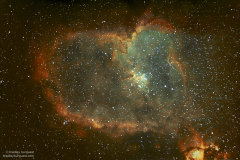What is narrowband astrophotography?
When shooting deep sky objects in light-polluted skies, you need to filter out the light frequencies of the light-pollution. To do this, you use narrowband filters. Narrowband filters allow only narrow bands of selected light bands to go thru the filter eliminating the light-pollution but picking up the nebula light. To create a color RGB image different filter bands are used, one for H-alpha (H-α), one for Sulphur II, and one for Oxygen III emissions. These are the selected frequencies of light captured by the camera.
Using a monochrome camera, one created for astrophotography, several long-exposure photographs of the same deep sky object are taken in each light band. All the monochrome narrowband image data is combined into a single RGB false-color image using a program such as Adobe Photoshop. Because the narrowband data is not in the same frequencies as a regular RGB image we map the captured data to RGB channels in the following manner. The Sulfur image data is mapped to the Red channel, the H-α image data is mapped to the Green channel, and the Oxygen data is mapped the the Blue channel of the RGB image to create the famous Hubble Palette of false-color astronomical images. To see more detailed information on the subject, see this Wikipedia page.




